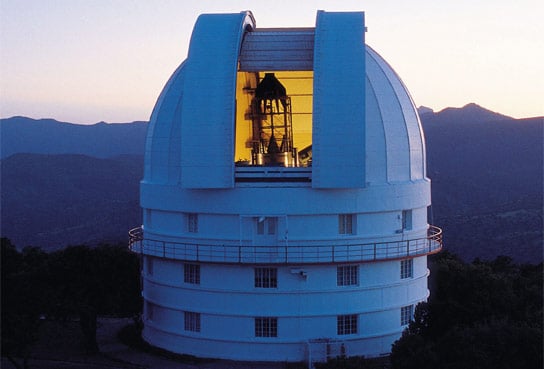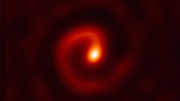
The 2.1-meter (82-inch) Otto Struve Telescope at the University of Texas McDonald Observatory. Credit: Marty Harris/McDonald Observatory.
Using the 2.1-meter Otto Struve Telescope, a team of astronomers have discovered pulsations from the crystalized remnant of the burnt-out star GD 518.
Austin — Astronomers from The University of Texas at Austin and colleagues have used the 2.1-meter Otto Struve Telescope at the university’s McDonald Observatory to discover pulsations from the crystalized remnant of a burnt-out star. The finding will allow astronomers to see below the star’s atmosphere and into its interior, much like earthquakes allow geologists to study compositions below Earth’s surface. The findings appear in the current issue of The Astrophysical Journal Letters.
The Texas astronomers made their discovery in collaboration with astronomers from Brazil’s Universidade Federal do Rio Grande do Sul, the University of Oklahoma, and the Smithsonian Astrophysical Observatory.
The star, GD 518, is roughly 170 light-years from Earth in the constellation Draco, but far too faint to be seen without a telescope. It is a white dwarf, a star at the end of its life cycle that is essentially just a burnt-out core, the ashy byproduct of previous epochs of nuclear fusion.
The star is unique in that much of it is likely suspended in a state more akin to a solid than a liquid or gas. The interiors of dying stars can become crystalized similar to the way in which frigid water freezes into ice, like the slow formation of glaciers in cooling ocean water.
“GD 518 is special because it is a very massive white dwarf: It has about 1.2 times the mass of the Sun, packed into a volume smaller than Earth,” said lead author J.J. Hermes, a graduate student at The University of Texas at Austin. “Few white dwarfs are endowed with so much mass, and this is by far the most massive white dwarf discovered to pulsate.”
The star also likely has an interior composed of heavier elements than those found in typical burnt-out stars.
Our Sun will only get hot enough in its center for nuclear fusion to burn hydrogen into helium, and in turn the helium to carbon and oxygen. The Sun will end its life in more than five billion years as a white dwarf with its central regions composed mostly of the nuclei of carbon and oxygen atoms.
But unlike the Sun, the star that died to become the white dwarf GD 518 was so massive —probably more than seven times the Sun’s mass — that it burned elements heavier than carbon and oxygen, and is now likely a white dwarf composed of oxygen and neon nuclei.
The discovery of pulsations —periodic brightness changes on the surface of a star that, in this case, keep a regular tune every 400-600 seconds — will allow astronomers an unprecedented opportunity to understand what makes up this highly evolved star’s interior.
Team member Barbara Castanheira is a postdoctoral researcher with McDonald Observatory. “Like a child at a museum, astronomers are only allowed to look, not touch, when they perform experiments,” Castanheira said. “This means we usually can only understand the surface of a star. Pulsations, like the sound of a bell, tell us more of the story, since they can unravel secrets about the much deeper interior of a star.”
White dwarf stars no longer fuse elements in their interior to generate energy; they simply cool, like coal embers removed from a fire. But at a certain point the atomic nuclei in the star’s interior get cool enough to begin to settle into a lattice structure and crystalize, just like water freezing into ice. This happens sooner in the interiors of more massive white dwarfs, and in the case of GD 518, it has likely started before the star had the right conditions to excite pulsations. The transition to a solid-like star should also affect the way the white dwarf vibrates from these pulsations.
Astronomers now face the difficult task of matching the pulsation periods observed in the star with those predicted by different models of the structure of its interior. The discovery observations show promise in this direction, Hermes said.
“We see evidence that the strength of pulsations in this star is very inconsistent; some nights the star is as still as a whisper,” he said. “This could be because the white dwarf is highly crystalized, and the pulsations are only allowed to propagate in a tiny bit of the outermost parts of the star. They thus have little inertia, and are more susceptible to changes than the pulsations in a typical pulsating white dwarf.”
University of Texas astronomers will continue watching GD 518 from McDonald Observatory, listening closely for any new notes that can unravel the song being sung by light from this ultramassive dying star.
This research has been supported by the Norman Hackerman Advanced Research Program and by the National Science Foundation. Established in 1932, The University of Texas at Austin McDonald Observatory near Fort Davis, Texas, hosts multiple telescopes undertaking a wide range of astronomical research under the darkest night skies of any professional observatory in the continental United States. McDonald is home to the consortium-run Hobby-Eberly Telescope, one of the world’s largest, which will soon be upgraded to begin the HET Dark Energy Experiment. An internationally known leader in astronomy education and outreach, McDonald Observatory is also pioneering the next generation of astronomical research as a founding partner of the Giant Magellan Telescope.
Reference: “Discovery of an ultramassive pulsating white dwarf” by J. J. Hermes, S. O. Kepler, Barbara G. Castanheira, A. Gianninas, D. E. Winget, M. H. Montgomery, Warren R. Brown and Samuel T. Harrold, 12 June 2013, The Astrophysical Journal Letters.
DOI: 10.1088/2041-8205/771/1/L2
arXiv:1306.4024









Be the first to comment on "Astronomers Discover Pulsations in Crystalized Remnant of Burnt-Out Star GD 518"